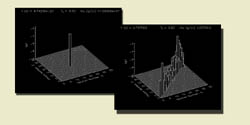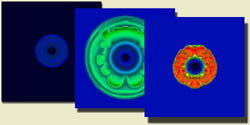 |
Hydrodynamic model of a SN collapse and explosion
| Credit: |
Adam Burrows & John Hayes |
| Comments: |
The top set of images links to a movie that follows the initial stages of the core
collapse. The bottom set links to a movie, which begins near the end
of the previous movie, and the scale has been enlarged to follow the
multi-dimensional explosion. |
| Publication: |
Burrows et al. 1995 |
|
 |
Hydrodynamic model of a SN collapse and explosion
| Credit: |
Adam Burrows & John Hayes |
| Comments: |
The colors indicate the electron fraction (Ye) |
| Publication: |
Burrows et al. 1995 |
|
 |
Hydrodynamic Model of a SNIa blast interacting with a main sequence star I
| Credit: |
Evonne Marietta |
| Comments: |
These results were featured on the cover of Nature in Feb. 2000. |
| Publication: |
Marietta et al. 2000 |
|
 |
Hydrodynamic Model of a SNIa blast interacting with a main sequence star II
| Credit: |
Evonne Marietta |
| Comments: |
This movie is different from the one above in that the distance between the exploding star and the companion star is greater. |
| Publication: |
Marietta et al. 2000 |
|
 |
Hydrodynamic Model of a SNIa blast interacting with a main sequence star III
| Credit: |
Evonne Marietta |
| Comments: |
This movie focusses on the inner interaction regions during the impact with a main sequence star. In addition, the velocity is represented by a vector field |
| Publication: |
Marietta et al. 2000 |
|
 |
3-D Hydrodynamic model of a meteor hitting an atmosphere
|
 |
Element Nucleosynthesis resulting from a shock passing through
Silicon (Si)
|
 |
Element Nucleosynthesis resulting from a shock passing through
Silicon (Si)
|
 |
3-D Hydrodynamic model of a spinning, collapsing SN core
|
 |
Hydrodynamic model of a SN core collapse (no explosion)
|
 |
R-mode instability of a neutron star
|
 |
3-D Hydrodynamic merger of two neutron stars
|
 |
"Kippenhahn diagrams": Dependence of stellar
evolution on 12C(alpha, gamma)16O
|
 |
Hydrodynamic Instabilities
| Credit: |
TBD |
| Comments: |
This simulation illustrates the tendency of alternating vortices to form downstream of a finite barrier in an otherwise uniform wind. |
| Publication: |
|
|














